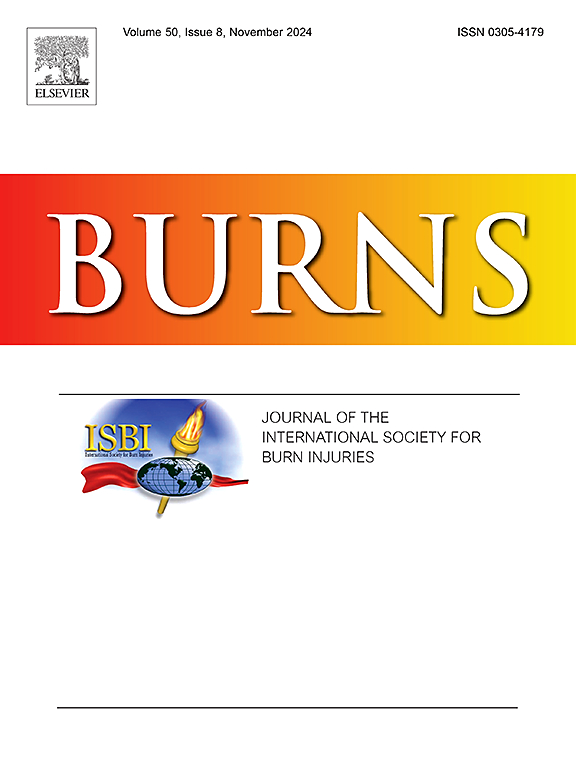捷克烧伤患者烧伤特异性疼痛焦虑量表(BSPAS)的翻译、适应和心理测量学评估
IF 3.2
3区 医学
Q2 CRITICAL CARE MEDICINE
引用次数: 0
摘要
本研究旨在调整烧伤特异性疼痛焦虑量表(BSPAS)在捷克语中的使用,并评估其效度和信度。该研究于2022年9月至2024年2月在捷克共和国的三所大学医院(布拉格、布尔诺和奥斯特拉瓦)进行,涉及203名符合纳入标准并同意参与的烧伤病房住院和门诊患者。适应过程包括严格的效度和信度分析,采用语言、内容和结构效度评估。语言效度通过回译来保证,内容效度通过专家评价来确认。探索性因子分析显示至少存在双因子结构,因子负荷令人满意。在BSPAS-9和BSPAS-5中,因子对问题的负荷是一致的。验证性因子分析进一步证实了模型对五项和九项版本的拟合(RMSEA分别为0.06和0.1)。使用项目-总量相关性评估内部一致性,产生可接受的结果(9个项目范围为0.63-0.82 ,5个项目范围为0.71-0.82 )。九项版本的Cronbach’s alpha系数为0.94,五项版本的Cronbach’s alpha系数为0.91。这些发现表明捷克版的BSPAS是评估烧伤患者疼痛相关焦虑的有效和可靠的工具。此外,我们表明,在我们的人群中,九项版本的信息被五项版本很好地捕获,疼痛本身解释了BSPAS分数的大部分差异。本文章由计算机程序翻译,如有差异,请以英文原文为准。
Translation, adaptation, and psychometric evaluation of the Burn-Specific Pain Anxiety Scale (BSPAS) for Czech patients with burn injuries
This study aimed to adapt the Burn-Specific Pain Anxiety Scale (BSPAS) for use in the Czech language and evaluate its validity and reliability. Conducted across three university hospitals in the Czech Republic—Prague, Brno, and Ostrava—from September 2022 to February 2024, the study involved 203 inpatients and outpatients from burn units who met inclusion criteria and consented to participate. The adaptation process included rigorous analysis of validity and reliability, employing language, content, and construct validity assessments. Language validity was ensured through back translation, whereas content validity was confirmed through expert evaluations. Exploratory factor analysis revealed at least a two-factor structure with satisfactory factor loading. Loading of factors to questions was consistent between BSPAS-9 and BSPAS-5. Confirmatory factor analysis further substantiated the model fit for both five- and nine-item versions (RMSEA 0.06 and 0.1 respectively). Internal consistency was assessed using item-total correlation, yielding acceptable results (range 0.63–0.82 for nine items and 0.71–0.82 for five items). Cronbach's alpha coefficients were 0.94 for the nine-item version and 0.91 for the five-item version. These findings indicate that the Czech version of the BSPAS is a valid and reliable tool for assessing pain-related anxiety in patients with burns. Additionally, we show that in our population, the information from the nine-item version is well captured by the five-item version and pain alone explains most of the variance in BSPAS scores.
求助全文
通过发布文献求助,成功后即可免费获取论文全文。
去求助
来源期刊

Burns
医学-皮肤病学
CiteScore
4.50
自引率
18.50%
发文量
304
审稿时长
72 days
期刊介绍:
Burns aims to foster the exchange of information among all engaged in preventing and treating the effects of burns. The journal focuses on clinical, scientific and social aspects of these injuries and covers the prevention of the injury, the epidemiology of such injuries and all aspects of treatment including development of new techniques and technologies and verification of existing ones. Regular features include clinical and scientific papers, state of the art reviews and descriptions of burn-care in practice.
Topics covered by Burns include: the effects of smoke on man and animals, their tissues and cells; the responses to and treatment of patients and animals with chemical injuries to the skin; the biological and clinical effects of cold injuries; surgical techniques which are, or may be relevant to the treatment of burned patients during the acute or reconstructive phase following injury; well controlled laboratory studies of the effectiveness of anti-microbial agents on infection and new materials on scarring and healing; inflammatory responses to injury, effectiveness of related agents and other compounds used to modify the physiological and cellular responses to the injury; experimental studies of burns and the outcome of burn wound healing; regenerative medicine concerning the skin.
 求助内容:
求助内容: 应助结果提醒方式:
应助结果提醒方式:


